Native American Hebrew and Greek language comparisons
There are examples of Hebrew customs, characters, beliefs and language among Native Americans. According to Mormon, they knew how to write in Hebrew and of course had Hebrew customs and beliefs (Mormon 9:33). The Greek language is also compared to the Native American languages of the Indians.
“The name of the Creeks for man, is ishto, and so it is in Hebrew…The same remark might be made with respect to the word Kenaai, for Canaan. Jehovah they call Y‑he-ho-wah. The roof of the house they call toubanora; in the Hebrew it is debonaour. The nose they call nichiri in Hebrew, neheri. The great first cause, Yo-hewah; in Hebrew, Jehovah. Praise the first cause, in their language, halleluwah; in Hebrew, hallelujah. Father they call abba; the same in Hebrew. Now they call na; in Hebrew, na. To pray they call pliale; in Hebrew, phalae. In their language, abel is manslaughter; the same in Hebrew. Wife, awah; in Hebrew, eve, or eweh. Winter, kora in Hebrew, cora. God, Ale; in Hebrew, Ale, or Alohini. A high mountain, ararat; the same by the Indians of Penobscot.” (Haywood 1823 pg. 282)
Silas T Rand knew several languages to include Hebrew concerning Micmac Indians:
“There are also some words in the language which resemble Greek. The Micmac word Ellenu, an Indian, is not very different from Hellene, a Greek. Ellenu esit (“He speaks Micmac”) is strikingly like the Greek, Hellenize (“He speaks Greek”). But in other respects the language resembles the Hebrew, especially in the suffixes by which the pronouns are connected in the accusative case with the verb.” (Silas T Rand 1893)
“Their languages are very diverse and differs as much from one another as Dutch, French, Greek and Latin. Declension and conjugation resemble those in Greek, for they, like the Greeks, Have duals in their nouns and even augments in their verbs.” (In Mohawk Country: Early Narratives About a Native People)
“Shilu in Indian is the same as Shiloh in Hebrew; the Indian word for father is Abba; the word for “waiter of the high priest” is Sagan in both Indian and Hebrew; the word for man in Indian is Ish or Ishie.” (Adair 1735)
Gaspesian/Micmac Indians:
“Our Indians agree with the Greeks and Latins in this, that they use always the singular, and almost never, or at least very rarely, the plural, even when they speak to their missionaries, or to some other person of prominence. They express themselves by the word kir^ which means “thou,” whether it is the child speaking to its father, the wife to her husband, or the husband to his wife.” (Clercq 1680 pg. 141)
“Antipas – name of a general in the BoM (Alma 56); name of a mountain in the BoM (Alma 47:7, 10); It is a Greek name, an abbreviation for ‘Antipater.’
Archeantus – Nephite commander (Moroni 9:2); a typical Greek formation, made using the Greek prefix ‘arch-‘ (“great, chief”), as in the Biblical Greek names Archelaus and Archippus.
Judea – the name of a Nephite city (Alma 56, 57); it is the Greek (i.e., New Testament) form of the Hebrew name ‘Judah,’ referring to the tribe, the Southern Kingdom, and the area of southern Palestine occupied by the tribe of Judah (the Jews).
Angola – city name at Mormon 2:4 – Greek ‘angelos’, meaning ’angel’”
Mormon 9:33 – And if our plates had been sufficiently large we should have written in Hebrew; but the Hebrew hath been altered by us also; and if we could have written in Hebrew, behold, ye would have had no imperfection in our record.
Native American and Hebrew beliefs and customs
In 1735, James Adair lived isolated among the North American Indians for 40 years. He wrote a book about their customs and practices of the Indians. In this book he postulated that the Indians are from the lost 12 tribes of Israel he stated 22 reason listed below:
“1. Their division into tribes. 2. Their worship of J‑hov‑h. 3. Their notions of a theocracy. 4. Their belief in the administration of angels. 5. Their language and dialects. 6. Their manner of counting time. 7. Their prophets and high priests. 8. Their festivals, fasts and religious rites. 9. Their daily sacrifice. 10. Their ablutions and anointings. 11. Their laws of uncleanliness. 12. Their abstinence from unclean things. 18. Their marriage, divorces and punishments of adultery. 14. Their several punishments. 15. Their cities of refuge. 16. Their purifications and preparatory ceremonies. 17. Their ornaments. 18. Their manner of’ curing the sick. 19. Their burial of the dead. 20. Their mourning for the dead. 21. Their raising seed to a deceased brother. 22. Their change of names adapted to their circumstances and times.”
(About Gaspesian/Micmac Indians)
“They say that when the sun, which they have always recognized and worshiped as their God, created all this great universe, he divided the earth immediately into several parts, wholly separated one from the other by great lakes : that in each part he caused to be born one man and one woman, and they multiplied and lived a very long time : hut that having become wicked along with their children, who killed one another, the sun wept with grief thereat, and the rain fell from the heaven in such great abundance that the waters mounted even to the summit of the rocks, and of the highest and most lofty mountains. This flood, which, say they, was general over all the earth, compelled them to set sail in their bark canoes.”
(Clercq 1680 pg. 85)
(Cherokee belief of a great deluge)
“A long time ago a man had a dog, which began to go down to the river every day and look at the water and howl. At last the man was angry and scolded the dog, which then spoke to him and said: “Very soon there is going to be a great freshet and the water will come so high that everybody will be drowned; but if you will make a raft to get upon when the rain comes you can be saved, but you must first throw me into the water.” The man did not believe it, and the dog said, “If you want a sign that I speak the truth, look at the back of my neck.” He looked and saw that the dog’s neck had the skin worn off so that the bones stuck out. Then he believed the dog, and began to build a raft. Soon the rain came and he took his family, with plenty of provisions, and they all got upon it. It rained for a long time, and the water rose until the mountains were covered and all the people in the world were drowned. Then the rain stopped and the waters went down again, until at last it was safe to come off the raft. Now there was no one alive but the man and his family, but one day they heard a sound of dancing and shouting on the other side of the ridge. The man climbed to the top and looked over; everything was still, but all along the valley he saw great piles of bones of the people who had been drowned, and then he knew that the ghosts had been dancing.”
(Mooney 1902 pg. 261)
(Gaspesian/Micmac Indians — Hebrew one year betrothal and dowry)
“The one of our Indians who wishes to marry a girl must live an entire year in the wigwam of his mistress’s father, whom he must serve and to whom he must give all the furs of moose and beavers which he kills in hunting. By the same law it is forbidden to the future husband and wife to abandon themselves to their pleasure.”
(Clercq 1680 pg. 238)
(Gaspesian/Micmac Indians — ancient Hebrew belief of a women being unclean during her menstrual period)
“A matter which is yet more surprising is this — they observe still to this day certain ceremonies of which they do not know the origin, giving no other reasons than that their ancestors have always practiced the same thing. The first is this, that the women and girls, when they suffer the inconveniences usual to their sex, are accounted unclean.”
(Clercq 1680 pg. 227)
(Gaspesian/Micmac Indians — This one is more Egyptian, but the Hebrews were once enslaved by the Egyptians.)
“I have learned only this from our Indians, that the chiefs of their nation formerly entrusted the bodies of the dead to certain old men, who carried them sacredly to a wigwam built on purpose in the midst of the woods, where they remained for a month or six weeks. They opened the head and the belly of the dead person, and removed therefrom the brain and the entrails.”
(Clercq 1680 pg. 302)
“They are either descendants of the lost tribes of Israel, or they have had, in some former era, a close contact and intercourse with the Hebrews, imbibing from them their beliefs and customs and the traditions of their patriarchs.”
(Warren Williams, Ojibwa History)
(Gaspesian/Micmac Indians)
“After the death of one’s brother, it is permissible to marry his wife, in order that she may have children of the same blood if she has not had any by her first husband.”
(Clercq 1680 pg. 228)
Greek Cross and the Sun Cross
The Greek style cross (a cross with all arms of equal length) dates back to 1600 BC. It’s a symbol found in ancient Greek temples.
It continued to be used by the early Christians after Christ’s death. It is a symbol of the Greek Orthodox Church, Egyptian gnostic Christians, and also used in Europe.
I believe the Celtic sun cross has its origins from the Greeks.
This is a symbol held sacred by many civilizations and groups of people that are found in the Middle East and Europe. Considering the DNA cultural and linguistic ties that Native Americans have to Greeks, Hebrews, and the Middle East. It should be no surprise that this symbol is also sacred to North American civilizations dating back to the Hopewell Indians.
Below are examples of the Greek/Sun Cross. I believe that Lehi and his family held this symbol to be an important and sacred symbol because the Egyptian hieroglyph for good is a circle with a Greek style cross on it and the plentiful use of this symbol found among the Hopewell and other pre-Columbian Indian cultures, and also held sacred by those cultures.
1600 BC marble sacral cross from the Temple Repositories of Knossos. (Heraclion Archaeological Museum, Greece):
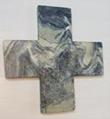
Coptic Cross used in the Middle East Earlier Greek Cross:
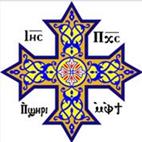
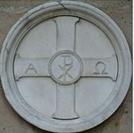
Early Christian Gnostic cross Celtic Sun Cross:
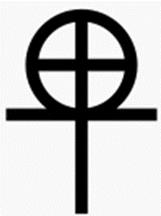
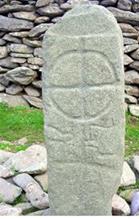
The remains of a Hopewell Greek-style Cross:
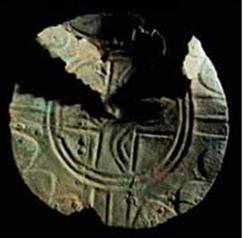
Mississippian artifacts of Greek-style Crosses:
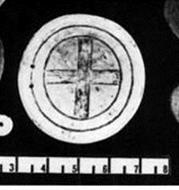
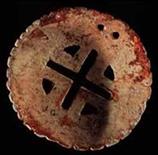
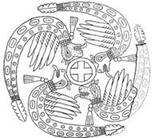
The example on the right is a Greek style gorget that would be worn as a necklace. Notice the Greek cross on clothing that appears to be a religious ceremony:
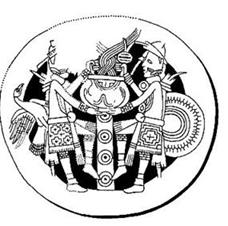
The Micmac Indian symbol for Holy:
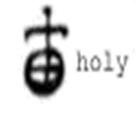
“In a stone grave in a small mound within an extensive fortifications on the banks of Big Harpeth River, two and a half miles from Franklin, on the plantation of General Graffenried, four copper crosses were exhumed, resting upon the skull of an old Indian. The copper had stained the bones of the cranium of a deep green color. In their general outlines two of these crosses presented the general contour of the human figure. The crosses appear to have been stamped upon the copper plates with a die.
(Jones, The American Naturalist, Vol 3 1869)
Swastika
Long before the swastika became an evil symbol of the Nazis, many ancient civilizations also used this symbol. The Greeks and Phoenicians used this symbol as did the Hopewell – making it another link that ties the two cultures together.
Hopewell Swastika dated to 200BC:
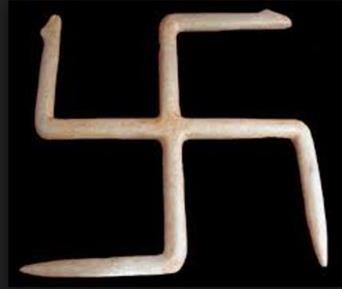
Greek vase dated before Book of Mormon times:
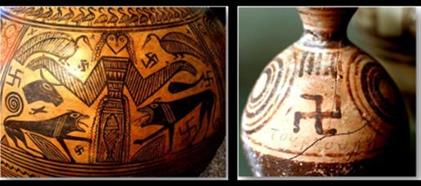
Greek Helmet dated to 380 BC, Greek Vase date to 750BC:
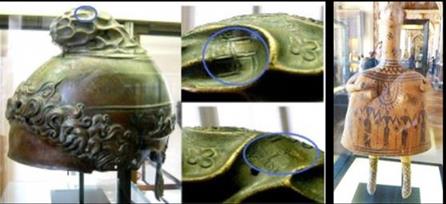
Native American Idioms and Phraseology
Native American idioms and phraseology, as described by early settlers, are consistent with the Old Testament and the Book of Mormon. Below are some examples of Native American idioms consistent with scripture. Examples are from John Heckewelder’s Manners and Customs of The Indian Nations Who Once Inhabited Pennsylvania and the Neighboring States.
Native American saying: “I will place you under my wings!”
Meaning: I will protect you at all hazards! You shall be perfectly safe, nobody shall molest you!
Scripture: 3 Nephi 10:6 O ye house of Israel whom I have spared, how oft will I gather you as a hen gathereth her chickens under her wings, if ye will repent and return unto me with full purpose of heart.
(Heckewelder pg. 139)
Native American saying: ”To bury deep in the earth” (an injury done)
Meaning: To consign it to oblivion.
Scripture: 2 Nephi 26:5 And they that kill the prophets, and the saints, the depths of the earth shall swallow them up, saith the Lord of Hosts; and mountains shall cover them.
(Heckewelder pg. 140)
Native American saying: “You have spoken with your lips only, not from the heart!”
Meaning: You endeavor to deceive me; you do not intend to do as you say!
Scripture: 2 Nephi 27:25 Forasmuch as this people draw near unto me with their mouth, and with their lips do honor me, but have removed their hearts far from me, and their fear towards me is taught by the precepts of men.
(Heckewelder pg. 139)
Native American saying: “draw the thorns out of your feet and legs, grease your Stiffened joints with oil, and wipe the sweat off your body.”
Meaning: I make you feel comfortable after your fatiguing journey, that you may enjoy yourself while with us.
Hebrew Custom: The washing of feet is a Hebrew custom. It was the first item done when entering a house or tent. The host would provide the water and the guest would wash his own feet. If the host was wealthy, a slave would wash the feet.
Anointing of oil was used by Jews to refresh and invigorate the body. This custom is still done today by Arabians. In the example there are some similarities in the cleaning of feet and legs from thorns and the anointing of oil or grease to refresh the body.
(Heckewelder pg. 139)
Hebrew and Hopewell Burial Method
The Hebrews would bury their dead in tombs. Then they would take the bones of their loved and put them in a stone ossuary.
The Hopewell Indians would bury their dead in tomb like structures in mounds. The Hopewell Indians would also bury their dead in stone-lined graves, like a Hebrew ossuary. Examples of Hebrew and Hopewell burials are shown below:
Tomb with rock benches: the Tomb of Kings, Jerusalem:
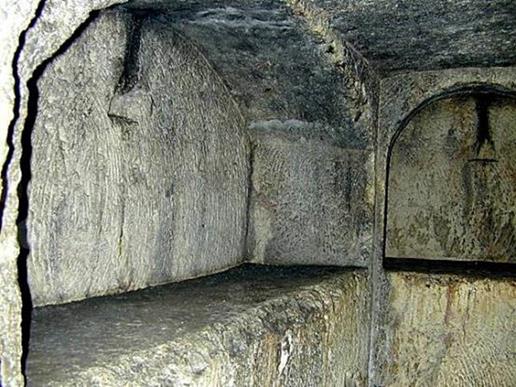
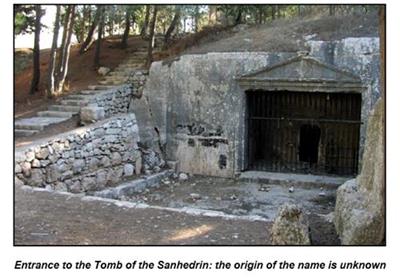
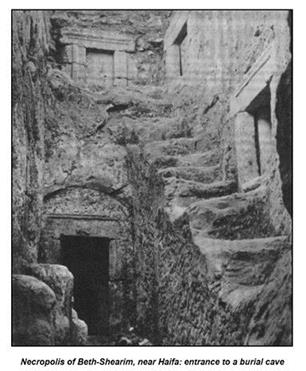
Canaanite tombs:
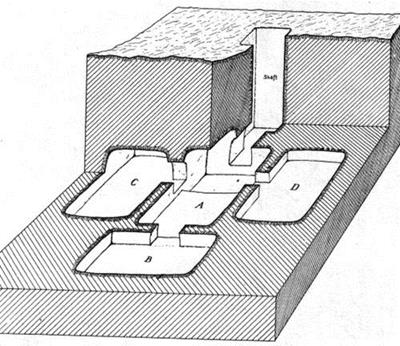
Hopewell Mound tombs:


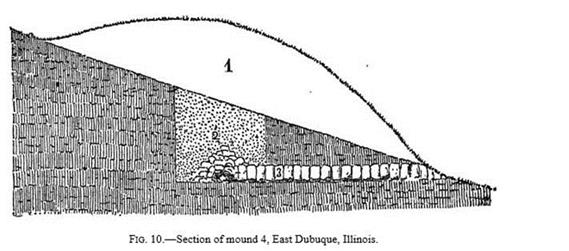
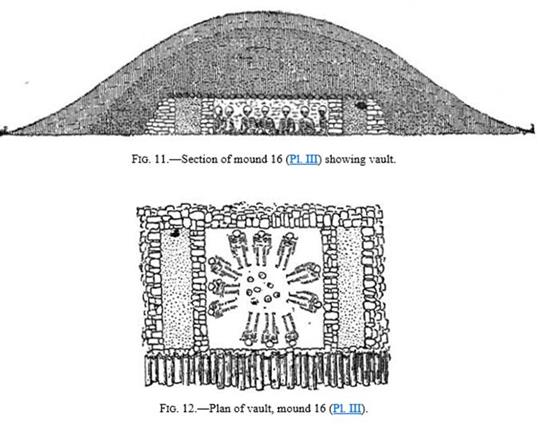
Hebrew Ossuary – Inscribed Simon the temple-builder:
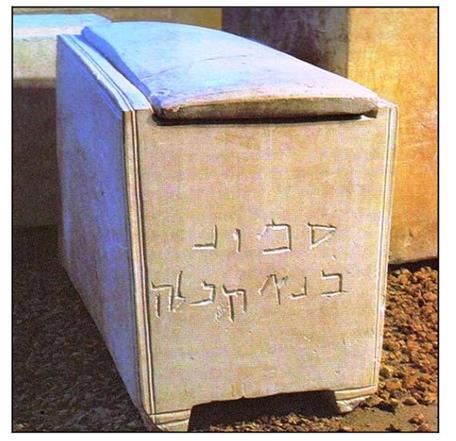
Hopewell like Ossuary:
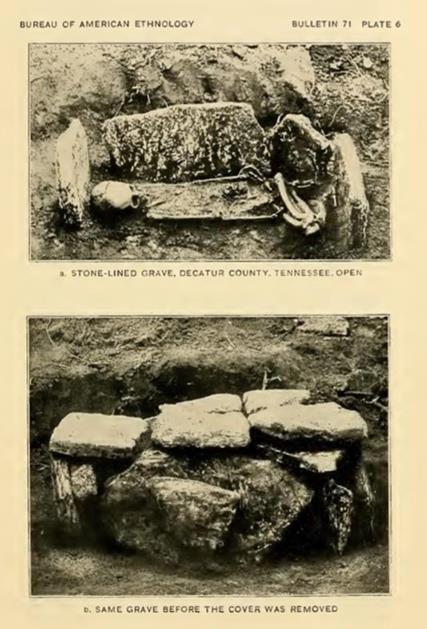
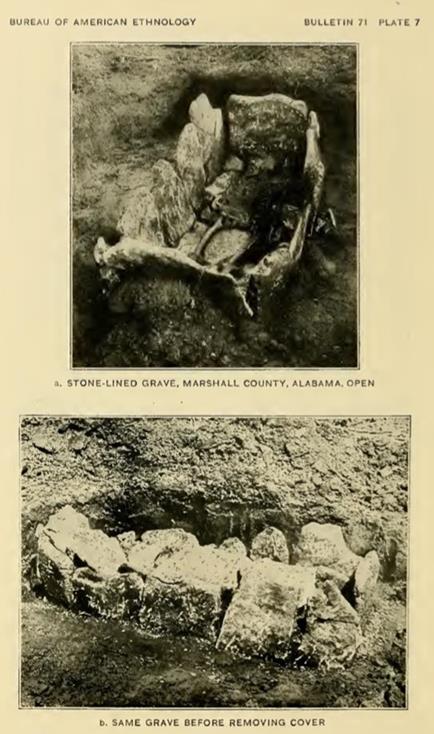
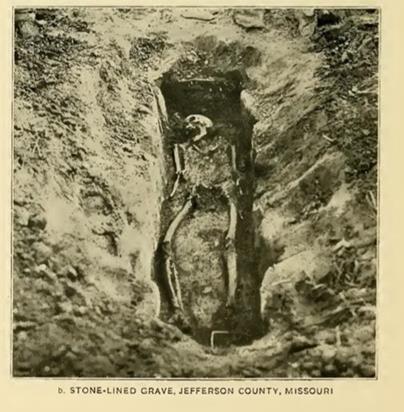
Temple/Masonic Medallion
“They call themselves Aquanuskion (Algonquin), or ye Covenant People.”
(Louise Welles Murray 1908)
(Gaspesian/Micmac Indians)
“Not an Indian would ever dare to appear before the others without having in his hand, on his skin, or on his garments this sacred sign.”
(Clercq 1680 pg. 147)
Mosiah 11:10 – And he also caused that his workmen should work all manner of fine work within the walls of the temple, of fine wood, and of copper, and of brass.
(In reference to the Natchez of Mississippi, who said a race that preceded them built temples with much skill, and also taught them to build temples)
“Their temples were built with much skill and labor. They made very beautiful things with all kinds of materials, such as gold, silver, stones, wood, fabrics, feathers, and many other things in which they made their skill appear.
“A remarkable temple was situated in the town of Talmaco, upon the Savannah River, three miles distant from Cutifatchique, near Silver Bluff. It was more than one hundred feet in length, and fifty feet in width. The walls were high in proportion, and the roof steep and covered with mats of split cane, interwoven so compactly that they resembled the rush carpeting of the Moors.”
(Jones, The American Naturalist, Vol 3 1869)
“In 1934, the Tennessee Valley Authority (TVA), was constructing a dam which would flood a portion of the Clinch River in East Tennessee. Because the area to be flooded included a Hopewell Native American mound, a group of archeologists were called in to excavate the site. The archeologists came upon an amazing discovery when they uncovered the ruins of a large stone and wood structure. So unlike any other find found at a Hopewell site, British Egyptologist, James Rendel Harris from the London Museum, was consulted. At the site, Harris identified the structure as an “Egyptian Temple”. A single newspaper article documents this account.
“In the center of the mound, about three feet from its surface, I uncovered a large sacrificial vase, or altar, forty-three inches in diameter, composed of a mixture of clay and river shells. The rim of the vase was three inches in height. The entire vessel had been molded in a large wicker basket, formed of split canes, and the leaves of the cane, the impressions of which were plainly visible upon the outer surface. The circle of the vase appeared to be almost mathematically correct. The surface of the altar was covered with a layer of ashes, about one inch in thickness, and these ashes had the appearance and composition of having been derived from the burning.”
(Jones, The American Naturalist, Vol 3 1869)
(During ancient times, Hebrews were commanded to maintain an eternal flame at the tabernacle/temple — Exodus 27:20, 21)
“Henri de Tonto, who travelled with de la Salle and wrote an extensive report, thought them most “polished” people he had seen. As with the Illinois and Natchez, they maintained a sacred fire that was never allowed to go out in their major Temple… an elaborate palace with decorated walls ten feet high.”
(A Cultural History of the Atlantic World, 1250–1820, by John K. Thornton)
“The Potta-wat-um-ees moved up Lake Michigan, and by taking with them, or for a time perpetuating the national fire, which according to tradition was sacredly kept alive in their more primitive days, they have obtained the name of “those who make or keep the fire,” which is the literal meaning of their tribal cognomen.”
(Warren Williams, Ojibwa History)
(Gaspesian/Micmac Indians)
“In a word, they value the [Greek style] Cross so highly that they order it to be interred with them in their coffins after death, in the belief that this Cross will bear them company in the other world, and that they would not be recognised by their ancestors if they had not with them the symbol and honourable token which distinguishes the Cross-bearers from all the other Indians of New France.”
(Clercq 1680 pg. 151)
(Incense)
To this day Native Americans hold tobacco sacred it is used in their religious ceremonies. As described by a Native American, when the tobacco smoke rises, it sends their prayers up to the creator. In the days of Moses and the Old Testament, incense was burned in the temple. It represented prayers ascending to God.
“Near Portsmouth, a flourishing town at the mouth of the Scioto, a medal was found in alluvial earth, several years since, by a Mr. White, a number of feet below the surface….This medal, I regret to state, is not in my possession, but it has been described to me by Gen. Robert Lucas and the Hon. Ezra Osborn, Esq. It was Masonic; the device on one side of it, represented a human heart with a sprig of cassia growing out of it; on the other side was a temple, with a cupola and spire, at the summit of which was a half moon, and there was a star in front of the temple. There were Roman letters on both sides of this medal, but what they were, Gen. Lucas and Judge Osborn have forgotten; they were probably abbreviations.”
(Atwater 1833, pg. 117)
The depiction on the right seems to show some type of religious ceremony being done in a bowl type altar. Notice the Greek style cross is present on the clothes of the Priest. The bowl on the left is an artifact that also gives the impression of an altar type vase. The bowl is from the Pine Tree Mound the depiction is from a Spiro Oklahoma artifact.
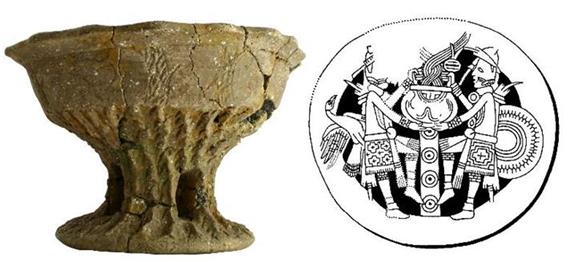
Below is an engineer drawing of an 1823 Hopewell mound believed to be fake? The engineer drawing was attributed to Maj. Isaac Roberdeau of a Hopewell mound in the shape of a Middle Eastern style lamp and menorah.
Hanukah happened after Lehi, so that is not a factor. But the menorah and eternal flame (oil lamp) were both commanded to be used in the temple by God. The menorah in this depiction is a nine stick menorah. According to Jewish traditions. A seven stick menorah could not be outside the temple. Jews would use a nine stick menorah outside the temple to adhere to the sacred nature of the menorah.
Hanukkah Mound and other Hopewell mounds:
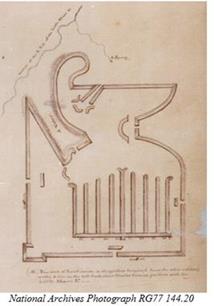
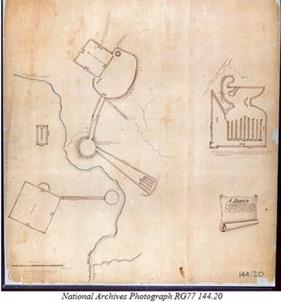
When studying the Natchez temples many of the same implements found in Hebrew temples was also present in the Natchez temple. In Hebrew temples, you have a rectangular shaped building with high walls, all constructed and furnished with great craftsmanship and lavishness. Inside you have the menorah, an eternal light (oil lamp), a veil, and the Ark of the Covenant. The Natchez have many similarities. They have an eternal fire that it is held with such regard that if it goes out those responsible for it are put to death. They have an altar inside their temple. They have a curtain or veil. Behind the veil is a wicker basket that no one is allowed to open. The way that the Wicker basket is presented in their temple behind a curtain that nobody is allowed to view may have similarities to the Ark of the Covenant.
The Native American greeting is quite interesting. I’m sure many older people have seen the old western cowboy and Indian movies. Native Americans have greetings that are reminiscent of sustaining church members in there calling during sacrament meeting. They also have other types of greetings. The Native American greeting is to bring the right arm to the square and say “how”.
The Algonquin Indians have another greeting that after you have made a friendship with that tribe. There is a special way using both hands to greet a member of that tribe to show a friendship or trust has been established with that tribe. I can’t vouch for the source. I received this picture from Wayne May:
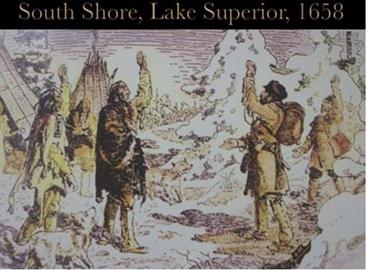
Freemasons of the 19th and 20th century have noticed similarities to Native American ceremonies and freemasonry. There have been some books written about this subject. Freemasons have assumed that the Native Americans have learned this from other Freemasons, but that is only an unverified idea. The other option is explained by the Bible and the Book of Mormon.
The Native American ceremony of Red Hand is very interesting. The tribes that conducted this ceremony in their long houses are the Iroquois, that being the Seneca, Cayuga, Onondaga, Oneida, or Mohawk. Keep in mind Red Hand is a Native American ceremony, nothing else. The account has been edited for relevance.
The proceedings began with 4 raps at the door. The candidate was brought in and listened to the story of Red Hand, the ancient leader. The candidate assumes the identity of the object of the story.
Red Hand was a young Chief who received certain mysterious knowledge from the Creator of All. He was kind, generous, and loved by all.
One day in battle, a poisoned arrow felled him. The enemy Indian rushed upon him, demanding the secret of his power or his life. Red Hand refused to divulge the secrets, so he was scalped.
A lone wolf came upon the body and howled so loud he brought all the animals from the forest. They each contributed a part of their bodies and revived the scalp, which they put on Red Hand’s head. They formed a circle around him and chanted for signs of life. Red Hand listened with his eyes closed when a voice asked him these questions:
VOICE: “Hast thou cleansed thyself from human guilt and impurity?”
RED HAND: “I have.”
VOICE: “Hast thou ill will toward any of thy fellow creatures?”
RED HAND: “I have not.”
VOICE: “Wilt thou trust and obey us, keeping thyself always chaste and valorous?”
RED HAND: “I will.”
VOICE: “Wilt thou hold this power with which we endow thee for thine own chosen company only?”
RED HAND: “I will.”
VOICE: “Wilt thou endure death or torture in its cause?”
RED HAND: “I will.”
VOICE: “”Wilt thou vow this secret never to be revealed save at thy death hour?’
RED HAND: “I will.”
VOICE: “Thy death hour will be revealed to thee; thou wilt be allowed to choose thy successor, and at the end of thy journey thou wilt be rewarded for faith and obedience.”
The circle drew closer and the brother who is the bear touched the breast of Red Hand. All stood erect. The bear grasped the hand of the leader who was to be raised, though slain, and by a strong grip pulled Red Hand to his feet.
http://www.phoenixmasonry.org/native_american_rituals.htm
Book of Mormon ties
Listed are what I believe to be ties to the Book of Mormon, either through legend or culture.
Christ’s Visit
Book of Mormon states that Jesus Christ after his resurrection visited the American Indians after great natural disasters among the Nephites. Christ taught the people the gospel, he showed them the imprints in his hand, ordained disciples and performed miracles among the people. There are some Indian legends that support this visit.
3 Nephi 17:3
3 Therefore, go ye unto your homes, and ponder upon the things which I have said, and ask of the Father, in my name, that ye may understand, and prepare your minds for the morrow, and I come unto you again.
(Iroquois Legend)
“The visitor appeared very old man; he appeared among the people for a while; he taught them many things; how to respect their deceased friends, and to love their relations and he informed the people that the whites beyond the great water had killed their Maker, but he rose again.”
(Cusick 1838 pg. 31)
(Gaspesian/Micmac legend of a beautiful person who in a time of turmoil visited them. He taught them and performed miracles. The sleep mentioned in the quote would make sense during the three days of darkness mentioned in 3 Nephi. The cross mentioned in the quote is the Greek style cross — not to be confused with the evangelical cross. The Greek cross is a sacred symbol found in prehistoric Indian civilizations.)
“They claim that, at a time when their country was afflicted with a very dangerous and deadly malady which had reduced them to an extreme destitution in every respect and had already sent many of them to their graves, certain old men of those whom they considered the best, the wisest, and the most influential, fell asleep, all overwhelmed with weariness and despair at seeing a desolation so general and the impending ruin of the entire Gaspesian nation … It was, say they, in this sleep filled with bitterness that a man, beautiful as could be, appeared to them with a Cross in his hand. He told them to take heart, to go back to their homes, to make Crosses like that which were shown them, and to present these to the heads of families with the assurance that if they would receive the Crosses with respect they would find these without question the remedy for all their ills. And so it turned out in fact, for the sickness ended, and all the afflicted who used the Cross with respect were restored miraculously to health. In this they were more happy.”
(Clercq 1680 pg. 172)
(Foretelling Christ’s visit to America there were incredible natural disaster. The Dakota Indians tell of an event passed down that matches the destruction explained in the Book of Mormon. The Dakota Indians explain that during a great and terrible tempest, with forked lightening and quaking of the earth an enemy Iowa village was ploughed to the earth to become a deep ravine where the village once stood. The Book of Mormon states in 3 Nephi Chapter 8 there were “terrible tempest”, “terrible thunder”, “exceedingly sharp lightnings”, ”exceedingly great quaking of the whole earth”, ”many smooth places became rough”, “And many great and notable cities were sunk”.)
“The thunder, which the Dakotas believe to be a winged monster, and which in character seems to answer very well to the Mars of the ancient heathen, bore down upon the Iowa village in a most terrible and god-like manner. Tempests howled, the forked lightnings flashed, and the thunders uttered their voices; the earth trembled; a thunderbolt was hurled at the devoted village, which ploughed the earth, and formed that deep ravine.”
(Miner 1911 pg. 29)
(Father Clercq believed that the Gaspesian/Micmac Indians were taught the belief of the cross and the Christian gospel by previous missionaries, the Gaspesian Indians said differently)
“One day to make these pagans admit that the missionaries who had preceded me had taught them the manner in which they ought to worship the Cross, the leading person said to me, “Well, now, thou art a Patriarch. Thou wishest that we believe everything that thou tellest us, but thou art not willing to believe that which we tell thee. Thou art not yet forty years old and for only two hast thou dwelt with the Indians; and yet thou pretendest to know our maxims, our traditions, and our customs better than our ancestors who have taught them to us. Dost thou not still see every day the old man Quioudo, who is more than a hundred and twenty years old: He saw the first ship which landed in our country. He has repeated to thee often that the Indians of Mizamichis have not received from strangers the use of the Cross, and that his own knowledge of it has been derived through tradition from his fathers, who lived for at least as long a time as he.”
(Clercq 1680 pg. 191)
The New Madrid Fault
The New Madrid fault lies along the Mississippi river and has earthquakes that match the earthquake mentioned in the Book of Mormon that preceded Christ’s visit to America. It’s also worth noting that, as described in D&C 125:3, Zarahemla is along the Mississippi river, in the earthquake zone of the New Madrid Fault.
The Book of Mormon describes areas of land that sank and lands that lifted and shaking that lasted for long periods of time. It also describes a vapor of darkness to the point that they could not light fires.
Now compare eyewitness accounts of a New Madrid quake that happened in 1811. Quotes come from the Joseph Knew website.
“In all the hard shocks mentioned, the earth was horribly torn to pieces – the surface of hundreds of acres, was, from time to time, covered over, in various depths, by the sand which issued from the fissures, which were made in great numbers all over this country, some of which closed up immediately after they had vomited forth their sand and water, which it must be remarked, was the matter generally thrown up. In some places, however, there was a substance somewhat resembling coal, or impure stone coal, thrown up with the sand. It is impossible to say what the depths of the fissures or irregular breaks were; we have reason to believe that some of them are very deep.” – Eliza Bryan
“The surface was sinking and a black liquid was rising up to the belly of my horse, who stood motionless, struck with a panic of terror […] water spouts, hundreds of them throwing water and sand were to be observed on the whole face of the country, the sand forming miniature volcanoes, whilst the water spouted out of the craters; some of the spouts were quite six feet high… In a few minutes, on both sides of the road as far as the eye could see, was vast expanse of sand and water, water and sand. The road spouted water, and wide openings were to be seen across it ahead of me, then under me, and my [vehicle] sank while the water and sand bubbled, and spat and sucked till my axles were covered.” – J Fletcher
“I went ashore, and found the chasm really frightful, as it was not less than four feet in width and besides the bank had sunk at least two feet. I took the candle, examined to determine its length and concluded that it could not be less than eighty yards long.” – John Bradbury (on the Mississippi River)
“The earth was broken in many places and the openings filled with water. The houses much injured – the only brick chimney in the place entirely demolished…” – Daniel Bedinger
“We were visited by a violent shock of an earthquake, accompanied by a very awful noise resembling loud but distant thunder, but more hoarse and vibrating, which was followed in a few minutes by the complete saturation of the atmosphere, with sulphurious vapor, causing total darkness.” – Eliza Bryan
“A dense black cloud of vapor overshadowed the land.” – Godfrey LeSieur
Chattahoochee, Chattanooga Nephite Words
I believe that the Chattanooga and Chattahoochee names are derived from the Nephites. From the quote below Chattahoochee is not a Cherokee word but the Cherokee continued to use the name. Mooney believes the name can be attributed to the Algonquin/Great Lake Indians. I assume the Cherokee continued to use the name after they removed the Nephites/Hopewell from the Tennessee and Kentucky lands.
“A creek of the same name is one of the head-streams of Chattahoochee River, in White county, Georgia. The Cherokee pronounce it Tsikama’gi, applying the name in Tennessee to the territory about the mouth of the southern, or principal, stream, where they formerly had a town, from which they removed in 1782. They state, however, that it is not a Cherokee word and has no meaning in their language.
(Mooney 1902 pg. 413)
Kentucky “River of Blood”
Kentucky is a proposed Nephite land that saw so much blood and carnage that, after the Nephites were removed, the Cherokee and Sack Tribes refused to enter those lands. The Book of Mormon states that the Nephites dumped thousands of bodies of Lamanites slain into the River Sidon, which is likely the Mississippi River which borders Kentucky.
“An old Indian, in conversation with Colonel James F. Moore, of Kentucky, informed him that the western country, and particularly Kentucky, had once been inhabited by white people, but that they were exterminated by the Indians. That the last battle was fought at the falls of Ohio, and that the Indians succeeded in driving the Aborigines into a small island below the rapids, where the whole of them were cut to pieces. He said it was an undoubted fact, handed down by tradition, and that the colonel would have ocular proof of it when the waters of the Ohio became low. This was found to be correct, on examining Sandy Island, when the waters of the river had fallen, as a multitude of human bones were discovered. The same Indian expressed his astonishment that white people could live in a country once the scene of blood. The Indian chief called Tobacco, told General Clarke, of Louisville, that the battle of Sandy Island decided finally the fall of Kentucky, with its ancient inhabitants. General Clarke says that Kentucee, in the language of the Indians, signifies “river of blood.””
(M.H. Frost 1819; On the aborigines of the Western Countries)
“Colonel Joseph Daviess, when at St. Louis in 1800, saw the remains of an ancient tribe of the Sacks, who expressed some astonishment that any person should live in Kentucky. They said the country had been the scene of much blood, and was filled with the manes of its butchered inhabitants. He stated also that the people who inhabited this country were white, and possessed such arts as were unknown by the Indians.”
(M.H. Frost 1819; On the aborigines of the Western Countries)
“Colonel M’Kee, who commanded on the Kenhawa when Cornstalk was inhumanly murdered, had frequent conversation with that chief, respecting the people who had constructed the ancient forts. He stated that it was a current and assured tradition, that Ohio and Kentucky had been once settled by white people, who were possessed of arts which the Indians did not know. That after many sanguinary contests they were exterminated.”
(M.H. Frost 1819; On the aborigines of the Western Countries)
Kishkumen
An Ojibwa Indian Chief named Keeshkemun, who succeeded his father to be chief, is mentioned in Warren’s book, Ojibwa History. Keeshkemun sounds strikingly similar to Kishkumen the Gadianton leader and one of the cities mentioned in the Book of Mormon. In fact if you google Keeshkemun, Kishkumen will come up. Ojibwa have some of the highest haplogroup X DNA.
Native American Council Tower
Mosiah 2:7
7 For the multitude being so great that king Benjamin could not teach them all within the walls of the temple, therefore he caused a tower to be erected, that thereby his people might hear the words which he should speak unto them.
“Professor Carr of its once having supported a building similar to the council-house observed by Bartram on a mound at the old Cherokee town Cowe. Both were built on mounds, both were circular, both were built on posts set in the ground at equal distances from each other, and each had a central pillar. As tending to confirm this statement of Bartram’s, the following passage may be quoted, where, speaking of Colonel Christian’s march against the Cherokee towns in 1770, Eamsey says that this officer found in the center of each town ”a circular tower rudely built and covered with dirt, 30 feet in diameter, and about 20 feet high. This tower was used as a council-house… Mr. M. C. Bead, of Hudson, Ohio, discovered similar evidences in a mound near Chattanooga, and Mr. Gerard Fowke has quite recently found the same thing in a mound at Waverly, Ohio.”
(Thomas 1889 pg. 32)
The Lamanite Daughters
This is a stretch, but worth the effort. It has bits and pieces of the account of the Lamanite daughters. The Cherokee have a myth listed below, which I find ties to the Lamanite daughters who would go out to Shemlon to dance and make merry, but are abducted by the priests of Noah and become their spouses. The Lamanites try to find the daughters and blame the Nephites for their disappearance, which causes a war. This war continues until the Lamanites are told that the Nephites did not abduct the girls. The daughters stop the priests from being killed when they are found out.
“Allured by the haunting sound and diamond sparkle of a mountain stream, she wandered far up into a solitary glen[.] The dream picture of a fairyland was presently broken by the soft touch of a strange hand. The spirit of her dream occupied a place at her side, and, wooing, won her for his bride.
“Her supposed abduction caused great excitement among her people, who made diligent search for her recovery in their own villages. Being unsuccessful, they made war upon the neighboring tribes in the hope of finding the place of her concealment. Grieved because of so much bloodshed and sorrow, she besought the great chief[.] She appeared unto the chiefs in a dream (to stop the fighting).”
(Mooney 1902 pg. 478)
The Saying Bury the Hatchet
The Book of Mormon tells the history of the Anti-Nephi’s, a Lamanite people who no longer wanted to fight or kill other people. They made this covenant to God to longer fight by burying their weapons in the ground, never to use them again even in the case of self-defense for themselves or for their family.
The saying bury the hatchet comes from the Algonquin Indians of the Great Lakes area who also made peace by burying their weapons of war. As mentioned before, I think the Hopewell Indians are the best candidate to be the Nephites for numerous reasons — this is one of them.
The first mention of the practice in English is to an actual hatchet-burying ceremony.
Years before he gained notoriety for presiding over the Salem witch trials, Samuel Sewall wrote in 1680, “I write to you in one [letter] of the Mischief the Mohawks did; which occasioned Major Pynchon’s going to Albany, where meeting with the Sachem the[y] came to an agreement and buried two Axes in the Ground; one for English another for themselves; which ceremony to them is more significant & binding than all Articles of Peace[,] the hatchet being a principal weapon with them.”
(South Carolina and the Cherokee Nation 1785)
Treaty of Hopewell 1785, Keowee, South Carolina: signed by Col. Benjamin Hawkins, Gen. Andrew Pickens and Headman McIntosh, establishing the boundary of the Cherokee Nation. Use of the phrase ‘Bury the Hatchet: “ARTICLE 13. The hatchet shall be forever buried, and the peace given by the United States, and friendship re-established between the said states on the one part, and all the Cherokees on the other, shall be universal; and the contracting parties shall use their utmost endeavors to maintain the peace given as aforesaid, and friendship re-established.”
Hamsa Symbol
The Jewish hamsa is a symbol a hand with the all seeing eye in the palm is used by Jews and Arabians still to this day. This symbol is found in North America specifically the Mississippian native culture. The Mississippian culture is dated after the Hopewell and the Book of Mormon but I believe that they were strongly influenced or descendants of the Hopewell. The Jewish symbol is shown below as well as the Mississippian hamsa symbol.
An example of a Jewish hamsa Symbol:
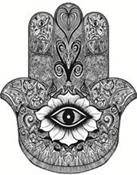
Native American rattlesnake disc artifact with hamsa symbol:
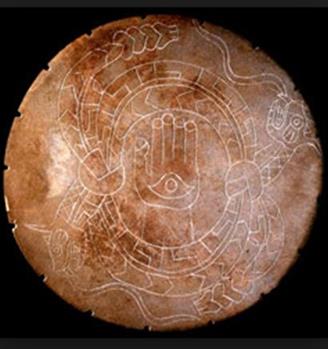
Horned Serpent
“Horned Serpents were major components of the Southeastern Ceremonial Complex of North American prehistory.” I believe it can be shown that the horned serpents of the Mississippian culture were influenced by the old world cultures just like there is shared DNA between Native Americans and the old world. The Assyrians believed in a horned serpent god, as do Native American cultures. Another is the above rattlesnake disc shown above. The horned serpent is sometimes shown with sacred symbols such as the sun cross or hamsa symbol.
(https://en.m.wikipedia.org/wiki/Horned_Serpent)
What makes this particular serpent interesting is not only the tie in with other sacred symbols, but the fact that horned snakes are not found in the eastern United States. The closest snake you get with horn like projections is the sidewinder found in the Mohave Deseret in the Southwest portion of the United States. On the other hand, in the desert of North Africa and the Arabian Peninsula is the desert horned viper with devil like horns on top of its head as shown below.
Deseret Horned Viper found in North Africa and Arabian Peninsula:
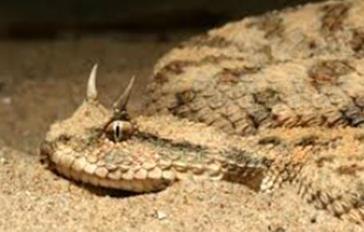
What also makes even more interesting is that in the Book of Mormon Nephi describes their written language as reformed Egyptian. The Egyptian hieroglyph for viper is a snake with horns on it. Whether or not this hieroglyph was used by Nephi and carried over to the New World can at this time only be speculated.
Egyptian Hieroglyph for Viper probably motivated by the Desert Honed viper found in Egypt:
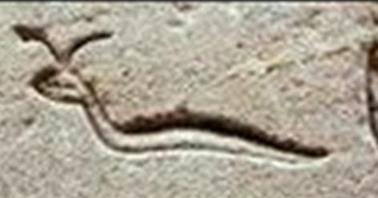
Several North American tribes believed in a horned serpent. Listed below are tribes that believed in a horned serpent and the name that they called it:
Gitaskog (Abenaki)
Hiintcabiit (Arapaho)
Jipijka’m (Micmac)
Kci-Athussos (Maliseet-Passamaquoddy)
Maneto (Fox)
Mehne (Cheyenne)
Mëxaxkuk (Lenape)
Misiginebig (Anishinabe)
Oniare (Iroquois)
Sint-holo (Choctaw)
Uktena (Cherokee)
Unhcegila (Lakota)
Weewillmekq (Maliseet-Passamaquoddy)
Fiery Flying Serpent
Nephi references the Old Testament story of the Children of Israel being bitten by Fiery Flying serpents and then having to look upon a staff with a serpent on it to be healed or death being the consequence from its bite.
Mississippian artifacts and Native American legend seem to confirm the account of such serpents.
“Those who know say the Uktena is a great snake…with horns on its head, and a bright blazing crest like a diamond on its forehead, and scales glowing like sparks of fire.”
(Mooney, James. Myths of the Cherokee. US Bureau of American Ethnology, 1897–8 Annual Report, 1902)
Mississippian depictions of flying serpents:
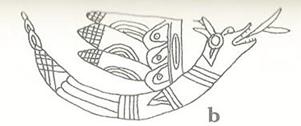
This depiction coincides with the sacred Greek Cross:
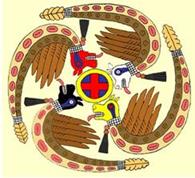
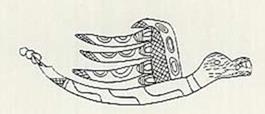
Assyrian
Ancient Mesopotamian Cuneiform tablets were found on Chief Joseph. Cuneiform dates back thousands of years to Mesopotamia, to what is now modern day Iraq. Assyrians also used a form of cuneiform. When Chief Joseph was asked where he got the tablets he said he received them from his forefathers.
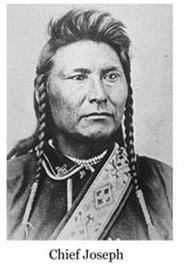
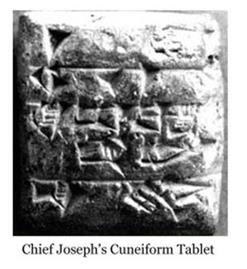
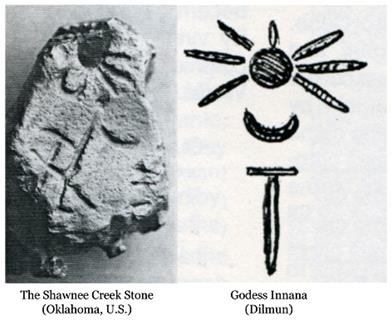
Nez Percé Baby 1911, Assyrian Woman 2500 BC:
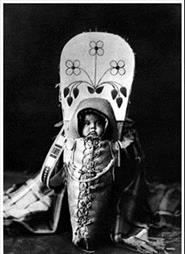
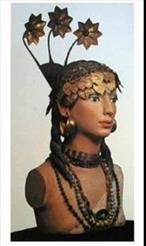
This is an ancient Assyrian relief sculpture. The Assyrian God Asher sits on his throne. In front of him is a four-pointed star with a circle in the center. Radiating out from between the four points of the star are rays of light. The rays of light radiate out in three ribbons:
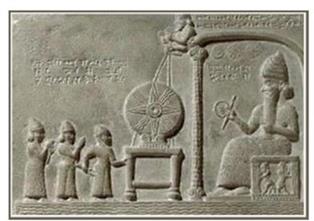
The Assyrian Flag:
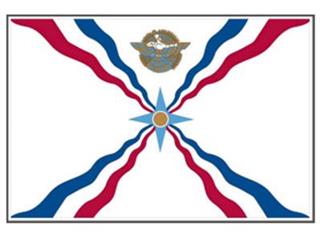
Chief Joseph not only had Cuneiform tablets but his medicine bag has what appears to have the Assyrian Star of Ashur. The star in the middle has four points and what would be the three ribbons of light coming from the four point star has three points at each end.
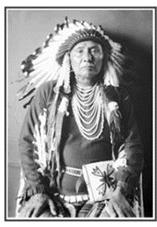
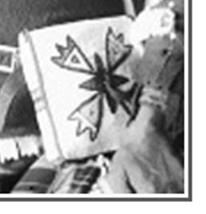
The Bible and the Book of Mormon explain why Native Americans/Lehi have Assyrian ties. Lehi was of the Tribe of Manasseh. The tribe of Manasseh and other Northern Kingdom tribes were conquered and taken over by the Assyrians in 723BC. The traditional lands of Manasseh become under Assyrian rule, some being deported to Assyria. In 2 Chronicles 30:1–11 explains that the Tribe of Manasseh was invited back to Jerusalem to worship back at the temple. 2 Kings 17:34 states that they no longer worshipped the God of Israel, most likely influenced by the Assyrian culture and beliefs provided by the Assyrians. Lehi ancestors very well could have been some of those invited back to Jerusalem and reconverted back to their ancestral beliefs. Those who rebelled against Nephi very easily could have reverted back to pagan beliefs of Assyrian origin.
Assyrian as well as Native Americans believed in a horned serpent — another obvious tie. The Assyrians were taken over by the Chaldeans, and parts of the Old Testament were written in Chaldean which would explain why Micmac character have what appear to be Chaldean similarities. (Ezra 4:8–6:18; 7:12–26; Jer. 10:11; Dan. 2:4–7:28)
This link between Native Americans and the old world is also genetically proven. It remains a mystery as to why Native Americans have genetic ties to the Middle East old world, but once again this genetic link is explained by the Bible and the Book of Mormon. An ocean voyage from the Middle East to the American continent provides an easy answer to anthropologist and geneticist questions regarding the old world genetic ties.
Based on biblical references about the tribe of Manasseh, they stopped worshipping the God of Israel. This is an explanation of why haplogroup X is not a genetic DNA marker of modern day Jews. The tribe of Manasseh fell away from traditional Hebrew beliefs because of Assyrian occupation and rule.
“We surveyed our Old World haplogroup X mtDNAs for the five diagnostic X2a mutations (table 2) and found a match only for the transition at np 12397 in a single X2* sequence from Iran. In a parsimony tree, this Iranian mtDNA would share a common ancestor with the Native American clade.”
(Origin and Diffusion of mtDNA haplogroup X, http://www.ncbi.nlm.nih.gov/pmc/articles/PMC1180497/)
Assyrians are traditionally from Iraq, but a minority of up to 200,000 had lived in Iran as of 1979.
Assyrian Crescent Moon
This theory is speculative, but it is quite possible the crescent shaped ornament worn by Native Americans is the Assyrian goddess Sîn.
Assyrian Relief to include sun and crescent moon and the worship there of:
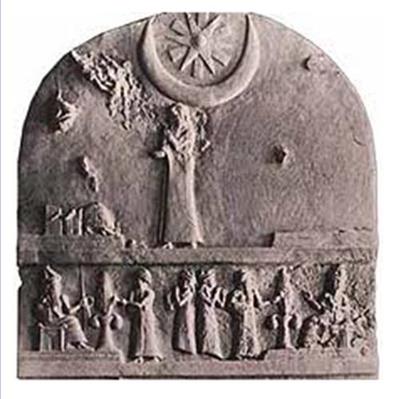
King Melishipak I (1186–1172 B.C.E.) presents his daughter. The crescent moon represents Sîn, while the sun and star represent Shamash and Ishtar:
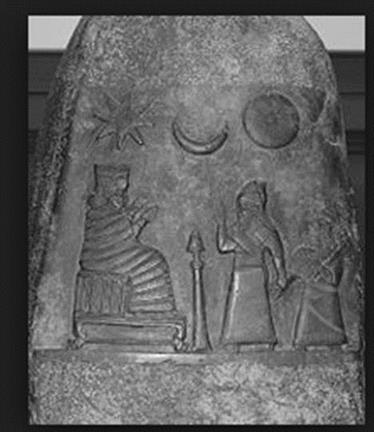
Once again the crescent moon goddess Sîn, is represented:
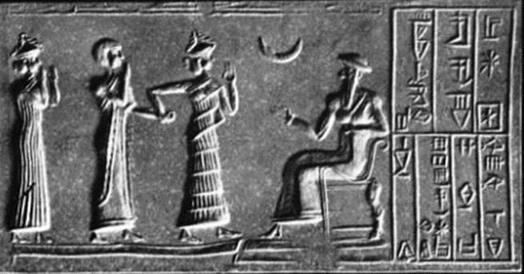
Examples of copper crescent shaped objects found in graves and paintings of 19th century Indians wearing crescent objects as necklaces.
(Jones Mound North Carolina)
Horizontal, face up, head southeast; shell beads around the neck, a hook or crescent shaped piece of copper on the breast.
(Cyrus Thomas)
(Etowah Mound Georgia concerning a grave)
The two crescent-shaped pieces are entirely plain, except some slightly impressed lines on the portion connecting them with the central stem.
(Cyrus Thomas)
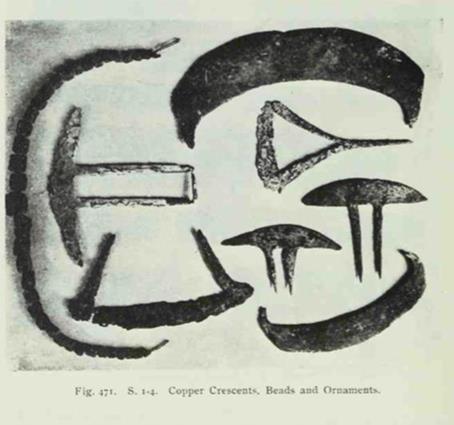
(Davis County Illinois)
Near the original surface, some 10 or 12 feet from the center, on the lower side, was discovered, lying at full length on its back, an unusually large skeleton….With it were three thin, crescent-shaped pieces of roughly-hammered native copper, respectively 6, 8, and 10 inches in length, with some small holes along the convex margin.
(Cyrus Thomas)
In this painting a Seminole Indian is wearing three crescent shaped objects:
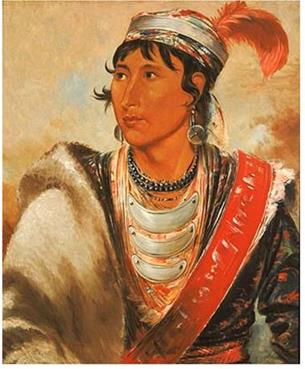
Seminole Lah-Shee
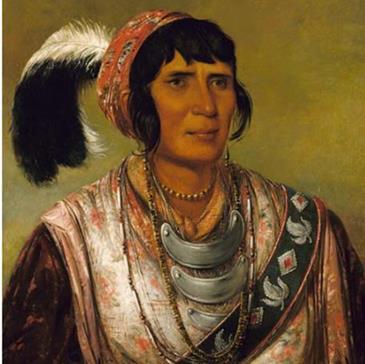
Seminole Os-ce-o-lá, the Black Drink, a Warrior of Great Distinction, 1838
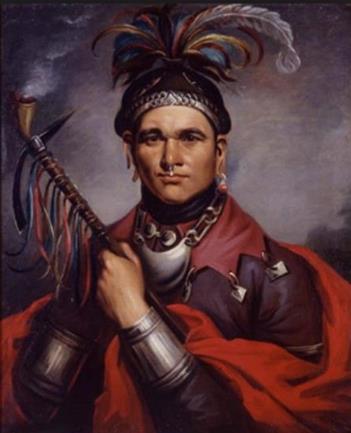
Chief Cornplanter, a Seneca war chief
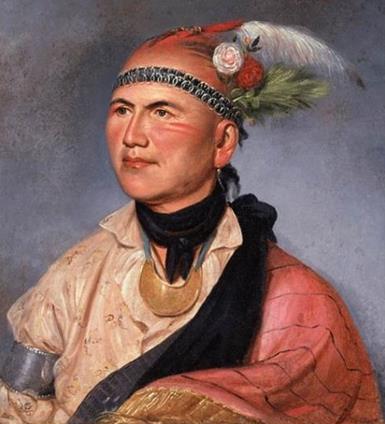
Thayendanegea Iroquois Chief
If the crescent shaped object represent the Assyrian God Sîn, one would not expect to find crescent shaped artifacts among Hopewell artifacts, or at the very least in limited quantity compared to other sites. This has been the case — archeologists were surprised that crescent shaped objects were not found at certain Hopewell sites.
“If the tabulation is valid, it indicated that statistically there should have been found at least one copper crescent at Hopewell.”
(The Adena 1974 pg. 214)
Seasons of War and Winter
Wars mentioned in the Book of Mormon were fought primarily between the first and fourth months mentioned in the Book of Mormon. During Nephite and Lamanite battles the Lamanites are described as wearing loin cloths. If the Nephite and Lamanite in the area between the Great Lakes and the Gulf of Mexico not going beyond the Rocky Mountains. How could the Lamanites wear loin cloths in the middle of winter when temperatures can drop below freezing? In the Hebrew calendar the first month is between March and April. This would mean that the Majority of wars were fought between spring and summer. Wearing loin cloths would not be a problem. But I know of one occasion mentioned in the Book of Mormon that a battle was fought during the winter and luckily it gives us a description of what the Lamanites were wearing Alma 49:6 “very thick garments to cover their nakedness”. The Lamanites known to wear loin clothes prepared themselves for battle with armor and thick garments. In this example there is obviously no conflict because of the wearing of thick garments.
Joseph Smith easily could have used the current Roman calendar to use for the Book of Mormon if it is a work of fiction. John Sorenson who is a famous Mesoamerican Archeologist espousing the Mesoamerican Book of Mormon geography model. He wrote the Mormon Codex considered the bible of the Mesoamerican Geography model. He at one time had the Nephites using a calendar similar to the Roman calendar. The one problem with this is that it would mean that Christ was crucified in January instead of April. If the Hebrew calendar is used this is not an issue.
Other verses that show that the Book of Mormon had seasons fitting the Heartland model are descriptions of migrating beast that migrated based on the season (Mosiah 18:4). Mesoamerica does not have migrating land mammals.
In Alma 46:40 it describes what sound like North America’s flu season fevers being common during the winter months of North America “there were some who died with fevers, which at some seasons of the year were very frequent in the land.”
James Adair wrote that the Cherokee Indians keep manner of time same as the Hebrews. While doing research I have noticed the same similarities with the Natchez of Mississippi.
“This nation begins its year in the month of March, as was the practice for a long time.”
(Swanton 1909 pg. 109)
The Natchez have 13 months in their calendar but that might be to account for the fact that the cycle of the Moon is longer than 365 days. The cycle of the moon is 375 days.
The Natchez also break up the day similar to the Hebrews.
Water of Mormon
There is also a good candidate for the waters of Mormon found in Missouri. Based on the geography and features of the suggested place and the description given by the Book of Mormon and D&C.
This is how Alma described the waters of Mormon Mosiah 18:5
5 Now, there was in Mormon a fountain of pure water, and Alma resorted thither, there being near the water a thicket of small trees, where he did hide himself in the daytime from the searches of the king.
What sticks out is it is described as a fountain of pure water.
Big Springs, Missouri fits this description. Big Springs is a single spring that has a daily out flow of 286 million gallons per day. Enough that the springs creates white water as it enters what appears to be glacial crystal clear pool of water. You can see the white water that is produced from the out flow of the spring. The pool of water is surrounded by a thicket of trees.
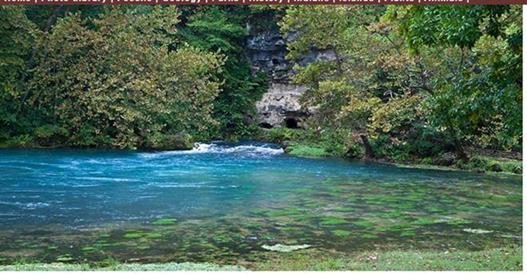
http://www.scienceviews.com/parks/bigspring.html
How do we know that the waters of Mormon should be in Missouri the Book of Mormon and Doctrine and Covenants helps answer that question?
Alma says in from Mosiah 18:4, 31
4 And it came to pass that as many as did believe him did go forth to a place which was called Mormon, having received its name from the king, being in the borders of the land
31 And these things were done in the borders of the land, that they might not come to the knowledge of the king.
So from these verses we learn that the Waters of Mormon are near the border of the land.
So how do we learn where the borders of the land are located that is deduced from D&C 54:8 when missionaries were sent out to Missouri. Missouri is stated as the borders of the Lamanite lands.
8 And thus you shall take your journey into the regions westward, unto the land of Missouri, unto the borders of the Lamanites.
The borders of the Lamanites is located in Missouri just like the Waters of Mormon would be located in Missouri. Its large outflow of water could easily be described as a fountain in its simplest terms.
Medicine
Alma 46:40
40 And there were some who died with fevers, which at some seasons of the year were very frequent in the land—but not so much so with fevers, because of the excellent qualities of the many plants and roots which God had prepared to remove the cause of diseases, to which men were subject by the nature of the climate—
(Gaspesian/Micmac Indians)
“They have, moreover, a quantity of roots and herbs which are unknown to us in Europe, but whose virtues and properties the Indians know wonderfully well, so that they can make use of them in time of need.”
(Clercq 1680, pg. 298)
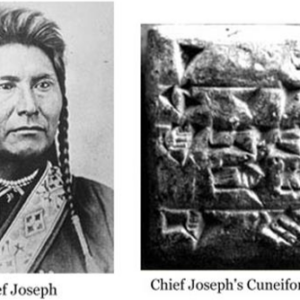
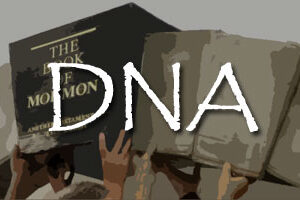
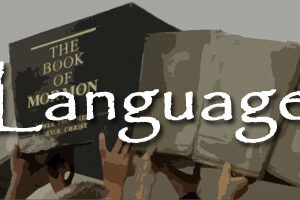
amazing job this was very validating as well as educating. So ready to see his children heal the wounds between mother Earth and man.
I do not dispute any of the wonderful truths published here, only want to point out we no longer need a denomination placed upon our selves. We are his children, his people. The names and misconceptions form from clouds, shades of segregation. Shalom